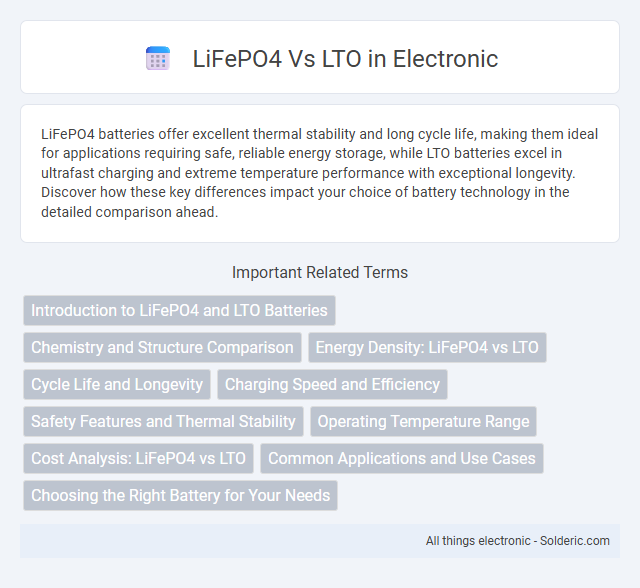LiFePO4 batteries offer excellent thermal stability and long cycle life, making them ideal for applications requiring safe, reliable energy storage, while LTO batteries excel in ultrafast charging and extreme temperature performance with exceptional longevity. Discover how these key differences impact your choice of battery technology in the detailed comparison ahead.
Comparison Table
| Feature | LiFePO4 (Lithium Iron Phosphate) | LTO (Lithium Titanate Oxide) |
|---|---|---|
| Energy Density | 90-160 Wh/kg | 60-110 Wh/kg |
| Cycle Life | 2000-5000 cycles | 7000-15000 cycles |
| Charge Time | 2-4 hours | 10-20 minutes |
| Operating Voltage | 3.2 V nominal | 2.3 V nominal |
| Safety | High thermal stability, non-combustible | Excellent thermal stability, very safe |
| Temperature Range | -20degC to 60degC | -30degC to 55degC |
| Cost | Moderate | High |
| Applications | Electric vehicles, solar storage, backup power | Fast-charging EVs, grid stabilization, military |
Introduction to LiFePO4 and LTO Batteries
LiFePO4 (Lithium Iron Phosphate) batteries offer high thermal stability, long cycle life, and enhanced safety, making them ideal for electric vehicles and renewable energy storage. LTO (Lithium Titanate Oxide) batteries provide ultra-fast charging, exceptional low-temperature performance, and extended lifespan, suited for high-demand applications like grid storage and electric buses. Choosing between LiFePO4 and LTO depends on your specific needs for energy density, charge speed, and operational environment.
Chemistry and Structure Comparison
LiFePO4 (Lithium Iron Phosphate) batteries feature a stable olivine crystal structure that ensures excellent thermal stability and long cycle life, while LTO (Lithium Titanate Oxide) batteries use a spinel structure with lithium titanate as the anode material, providing superior rate capability and ultra-fast charging. The LiFePO4 chemistry offers a higher energy density with a nominal voltage of 3.3V per cell, compared to LTO's lower voltage of 2.4V but enhanced safety and tolerance to extreme temperatures. Your choice depends on the need for energy density versus rapid charging and extreme durability, reflecting the fundamental differences in their chemical composition and crystal lattice configurations.
Energy Density: LiFePO4 vs LTO
LiFePO4 batteries offer an energy density of approximately 90-160 Wh/kg, making them more suitable for applications requiring higher capacity and longer runtime. LTO (Lithium Titanate Oxide) batteries typically have a lower energy density around 60-110 Wh/kg but excel in fast charging and extended cycle life. When choosing between LiFePO4 and LTO, your priority on energy density versus charge speed and longevity will determine the ideal battery type for your needs.
Cycle Life and Longevity
LiFePO4 batteries typically offer a cycle life of 2,000 to 5,000 cycles, making them highly durable for long-term energy storage applications. In contrast, LTO (Lithium Titanate) batteries excel with an exceptionally long cycle life exceeding 10,000 cycles, providing superior longevity for demanding, high-cycle environments. Your choice depends on balancing the extended lifespan of LTO with the cost-effectiveness and reliability of LiFePO4 technology.
Charging Speed and Efficiency
LiFePO4 batteries offer moderate charging speeds with high efficiency, typically accepting charge rates up to 1C, making them suitable for applications requiring balanced performance and safety. LTO batteries excel in ultra-fast charging, capable of 10C charge rates or higher, delivering superior charge-time efficiency and extended cycle life due to their stable chemistry. Your choice between LiFePO4 and LTO should consider the importance of rapid recharge times versus overall energy density and cost.
Safety Features and Thermal Stability
LiFePO4 batteries offer exceptional safety features due to their stable olivine structure, which resists thermal runaway and reduces the risk of fire or explosion under extreme conditions. LTO batteries provide superior thermal stability with an operating temperature range from -30degC to 55degC, making them highly resistant to overheating and ideal for applications requiring rapid charge and discharge cycles. Your choice between LiFePO4 and LTO should consider these safety and thermal characteristics to ensure optimal performance and reliability in your specific use case.
Operating Temperature Range
LiFePO4 batteries typically operate efficiently within a temperature range of -20degC to 60degC, providing stable performance in various climates. LTO (Lithium Titanate Oxide) batteries excel in extreme conditions, functioning between -40degC and 70degC, ideal for harsh environments and rapid charging scenarios. The wider operating temperature range of LTO batteries makes them suitable for applications requiring reliability under severe thermal stress.
Cost Analysis: LiFePO4 vs LTO
LiFePO4 batteries typically offer a lower upfront cost compared to LTO batteries, making them more accessible for large-scale energy storage and electric vehicle applications. Although LTO batteries have a higher initial price, their superior cycle life and faster charging capabilities can lead to reduced total cost of ownership over time. Cost analysis must consider both initial investment and long-term performance metrics to determine the most economical choice for specific use cases.
Common Applications and Use Cases
LiFePO4 batteries are widely utilized in electric vehicles, solar energy storage systems, and portable power tools due to their high energy density, long cycle life, and safety stability. Lithium Titanate (LTO) batteries excel in applications requiring ultra-fast charging and extreme temperature tolerance, such as electric buses, military equipment, and grid frequency regulation. Both chemistries offer distinct advantages making them suitable for specific energy storage needs in transportation, renewable energy, and industrial sectors.
Choosing the Right Battery for Your Needs
LiFePO4 batteries offer high energy density and long cycle life, making them ideal for renewable energy storage and electric vehicles. LTO batteries excel in rapid charging, extreme temperature tolerance, and exceptional lifespan, suitable for high-power applications and frequent cycling. Understanding your energy requirements and usage patterns ensures the right choice between LiFePO4 and LTO for your specific needs.
LiFePO4 vs LTO Infographic

 solderic.com
solderic.com